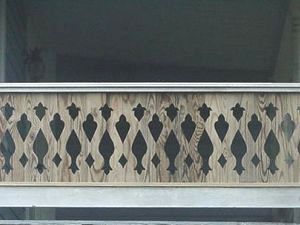


|

|
Sawn Baluster Porch Railing |
|
Why not add a little Victorian millwork to your porch? Even if you do not own a band or scroll saw, you can add old-style ornamental carpentry look in this weekend project. Once very popular in nineteenth-century homes, decorative millwork is being revived. In this article we'll show you how to cut your own sawn balusters and install a porch railing. You can be creative and distinguish your property from the pressure-treated sea of 2x2 stick balusters, seen everywhere. |
 |
|
Items needed:
Band or scroll saw
Ruler and marker pen Screw driver Table saw Sandpaper Drum sander Primer and paint |
Safety Suggestions and Tips
Caution using ladder
Use eye protection with power tools |
Level of difficulty
 Time Required: 8 hour
|
|
|
|
Steps |
|
|
|
|
Step 1: The design for your ornamental sawn baluster determines the look and feel for the porch. You can exaggerate the height, openness and style depending on the pattern. |
|
Step 2: You don't even need a hole saw to create the effect. Sawn balusters are typically offered in the following sizes: Widths: 3-1/2, 5, 7 and 8 1/2" |
|
Step 3: The overall height from the deck or flooring of the a typical railing height is 34-38". Be sure to check local building codes for the minimum required height. Use this to calculate the length of the baluster needed subtracting the thickness of the hand and shoe railing and clearance space. The space between the deck or flooring and the bottom rail should be 4", although some local building codes may allow more space. Remember you don't want an infants head to get stuck there. We made up this design. For a larger image which you can download and create your own template, click here. This will open a new window where you can "Save Picture As" or "Save Image As". There are many variations. |
|
Step 4: Sawn balusters price can be found in a wide variety of styles and the prices vary depending on the size and material. Less expensive ones can be found for $7-12 whereas the more intricate and larger ones are $20-27. Two of the best materials are kiln-dried redwood or cypress. This was not readily available for our project and we used conventional pressure-treated pine. |
|
|
|
|
|
|
|
Related articles
|
||||